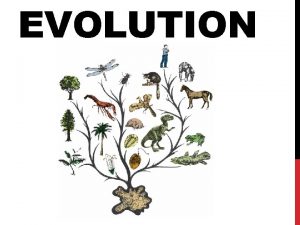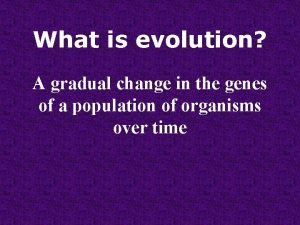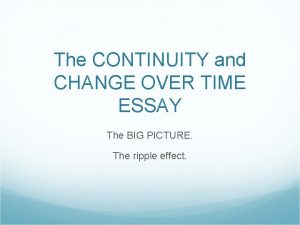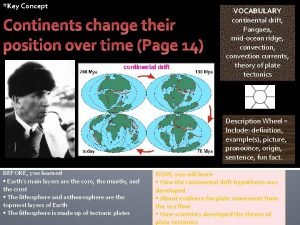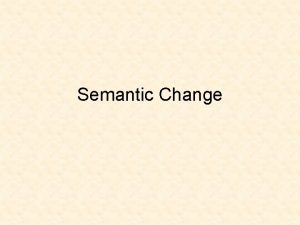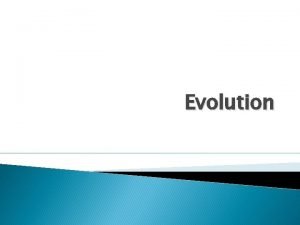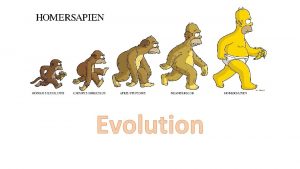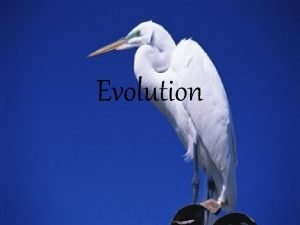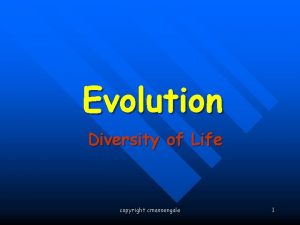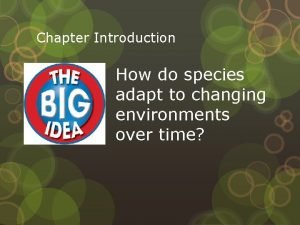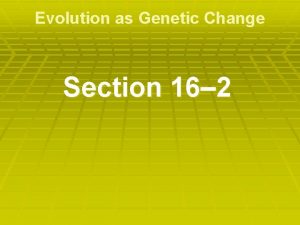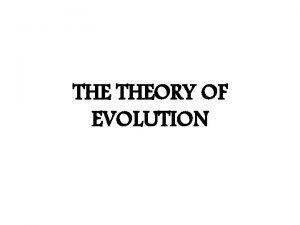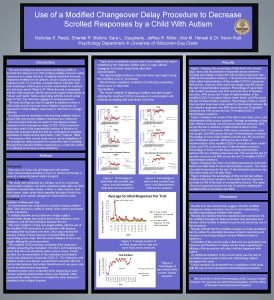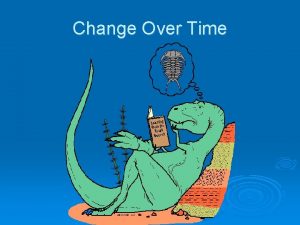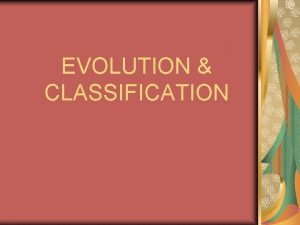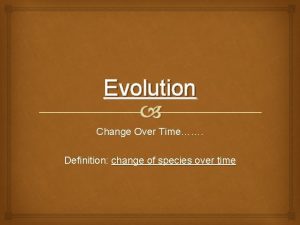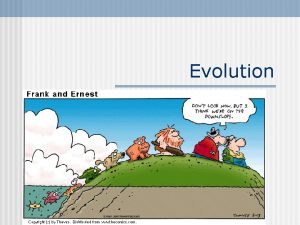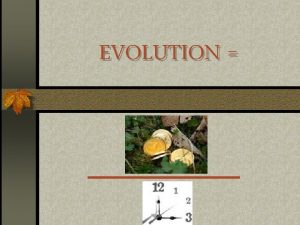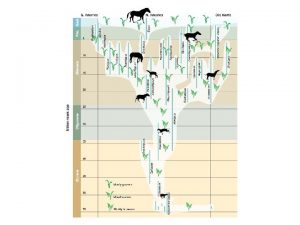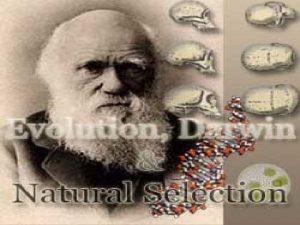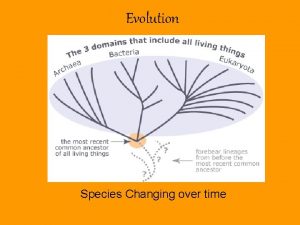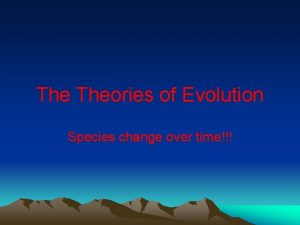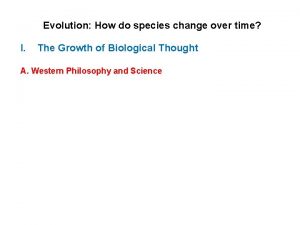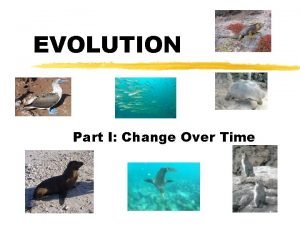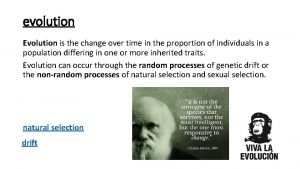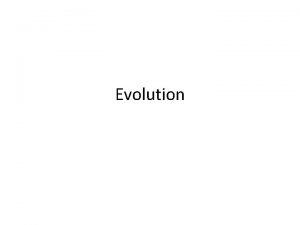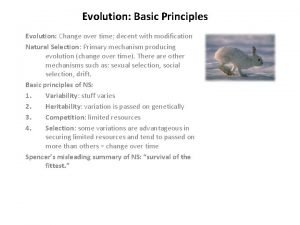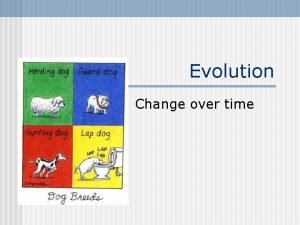Evolution a change in a species over time






























- Slides: 30

Evolution a change in a species over time

There are many types of evidence that support theory of evolution • • 1. Anatomical Evidence: 2. Fossil Evidence: 3. Radioactive dating: 4. Relative Dating: 5. The Fossil Record 6. Embryological Evidence: 7. Chemical Evidence: 8. The Molecular Clock:

1. Anatomical Evidence: • In the early 1800's, The French biologist Lamarck began to look at similar structures in different species. • These homologous structures are body parts and organs that are similar. • EX: bat’s wing, dolphin’s • flipper

Theory of Use and Disuse • Lamarck • that individuals would acquire or lose structures through their use or disuse. EX: A giraffe got its long neck by stretching for the highest leaves. It then passed this trait on to its offspring.

Problems • tailbone • Appendix • Neither one is still used but we still have them. • Ex: Another scientist tested this by cutting the tails off mice.

2. Fossil Evidence: • Fossils- the imprints or remains of plants or animals that existed in the past • Fossils allow scientists to follow changes in organisms over time.

3. Radioactive dating: • elements that give off radiation as they decay • not all elements decay at the same rate • half-life- measuring the decay rate • non-radioactive element- the time it takes for ½ of the element to break down •

Carbon-14 is the radioactive form of carbon • half-life of 5, 770 years • All living things have carbon-14 • when the organism dies its C-14 starts to decay. • By measuring how much C-14 is left • tell how old the fossil is.

Example: • Carbon-14 is the radioactive form of carbon • half-life of 5, 770 years. • when the organism died it had 8 grams of C 14 • after 17, 310 years there was only 0. 5 grams remaining • How many half lives had it gone through?

A sample had 100 grams of C-14 • 50 grams after 1 half-life (5770 years) • 25 grams after 2 half-lives (11, 540 years) • 12. 5 grams after 3 half-lives (? ? ? Years)

Relative Dating: • compares the rock layers above and below the fossil • Layers of sedimentary rock toward the bottom are older • those toward the top are younger.

Which layer is older? C B A

Which layer is older? Which Layer is younger?

Relative time is recorded in rocks. Each of these rock layers represents a period of time in Earth's history, so the entire sequence of layers is another timeline.

As more and more layers are deposited, the older rock layers end up at the bottom of the sequence and the newer ones toward the top. The arrow shows the relative order of the rock layers from earliest to most recent.

Evidence of the events in Earth's history is found within the rocks. a. ) Brachiopod b. ) Eurypterid c. ) Trilobite d. ) Ammonite

5. The Fossil Record • This includes ALL of the fossil evidence scientists have collected Steno’s drawing of a shark head helped him see that “tongue stones” were actually fossil shark teeth (right).

Example • Some fossil bones of a leg and a foot were found in sedimentary rock in the Mississippi River valley. • Could tell from the bones: • 4 toes on each front foot • toes were spread apart. §Fossils found in the same layers helped them figure out it was probably the size of a cat, but had other traits of a horse. §They named it Eohippus = early horse.

They used radioactive dating • To determine the age to be about 50 million years. spread-apart toes would help it to walk on mud Other fossils in those layers : • climate was warm and wet • possibly a tropical climate surrounded by swamps and mud

Theory of evolution so far • • 1. Anatomical Evidence: 2. Fossil Evidence: 3. Radioactive dating: 4. Relative Dating: • 5. The Fossil Record

Scientists put all of this information together to help form a better idea of what an organism looked like, how it lived and how it changed over time

mutations • Changes in the DNA of organisms • Can cause changes in their appearance

ADAPTATION. • a change that makes it easier for an organism to survive One of the most difficult • animals that could not adapt became extinct.

6. Embryological Evidence: • Embryos are developing organisms. • Scientists compare the embryos of different species to see how closely related they are.

7. Chemical Evidence: • Chemical similarities in the DNA of different species = shows us how they might be related. • Ex: The DNA of a zebra and a quagga

8. The Molecular Clock: • The more similar the structure of protein molecules between 2 organisms, the more recent their common ancestor. • Scientists developed a time scale • how long it takes proteins to change over time • They use this to figure out how long ago a protein changed.

http: //www. ucmp. berkeley. edu/education/explorations/tours/geotime/gtpage 5. html http: //www. ucmp. berkeley. edu/education/explorations/tours/geo time/clonus/transparent. gif

Now let's make a similar timeline for some of the major events during the history of life on Earth. Here are pictures of some fossils. Your goal is to put them into the correct order of when they first appeared on Earth.

http: //www. ucmp. berkeley. edu/education/explorations/tours/geot ime/clonus/transparent. gif

Theory of evolution • 1. Anatomical Evidence: • 2. Fossil Evidence: • 3. Radioactive dating: • 4. Relative Dating: • 5. The Fossil Record • 6. Embryological Evidence: • 7. Chemical Evidence: • 8. The Molecular Clock:
 The gradual change in a species over time
The gradual change in a species over time Evolution is gradual
Evolution is gradual Keystone species plants
Keystone species plants Change over time essay
Change over time essay How do communities change over time
How do communities change over time Continents change position over time
Continents change position over time Semantic narrowing
Semantic narrowing The change in the hereditary features over time
The change in the hereditary features over time The gradual change in living communities
The gradual change in living communities The process of change over time is
The process of change over time is Change in hereditary features over time
Change in hereditary features over time Why do classification systems change over time?
Why do classification systems change over time? Geographic distribution of species evolution
Geographic distribution of species evolution Evolution of species 2
Evolution of species 2 Natural selection definition biology
Natural selection definition biology Start time, end time and elapsed time
Start time, end time and elapsed time Over the mountain over the plains
Over the mountain over the plains Siach reciting the word over and over
Siach reciting the word over and over Taking over navigational watch
Taking over navigational watch Section 16–2 evolution as genetic change
Section 16–2 evolution as genetic change Industry evolution and strategic change
Industry evolution and strategic change Slow evolution
Slow evolution What is direct changeover
What is direct changeover Change over delay
Change over delay Is painting a wall a physical change
Is painting a wall a physical change Physical change
Physical change Absolute change and relative change formula
Absolute change and relative change formula Define integers
Define integers Difference in physical and chemical changes
Difference in physical and chemical changes A change in supply vs a change in quantity supplied
A change in supply vs a change in quantity supplied Supply and demand curve shifts
Supply and demand curve shifts
